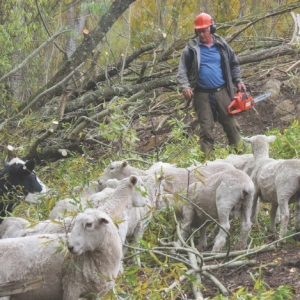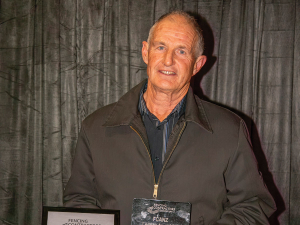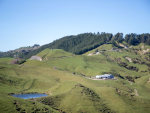Gordon, Federated Farmers Meat and Fibre chair in Manawatu/Rangitikei, lives in an area badly hit by drought. Since early February he has been forced to feed out – but not baleage or supplements. His stock are in paddocks where he grows Japanese fodder willows, so the chainsaw sound signals a hearty meal in the offing.
Gordon’s farm name, Wairere, means ‘flowing water’, but in seven months only 280mm rain has fallen – about half the normal annual rainfall.
The trees have helped through this terrible drought. Gordon has two varieties, Tangaio and Kinulagi, acquired from AgResearch in 1994. He set up a nursery and eventually built up a stock of some 4000 trees.
“I got them for erosion control – not fodder – and planted them after the big flood in 2004,” Gordon told Rural News.
“I selected these varieties because they weren’t going to grow into huge poplars, plus they could be coppiced for stock feed.
“I also planted them for the deer because the Kinulagi have 10% tannin in them and this reduces the need for drenching deer, which I had on the property at the time. Instead of drenching the deer, I just ran them through the block of trees once a month. The tannin doesn’t kill the worms but it paralyses them so they can’t breed.”
Gordon is running about 700 two-tooths and 40 cattle on the 5ha of trees. He recently fattened about 20 cattle solely on the Tangaio. The daily ration of trees he cuts is equivalent to about three bales of baleage, which could cost him about $200 each. “The trees are a very cost effective feed.”
Stock take a couple of days to get used to the willows; once they do they quickly recognise what the sound of the chainsaw means. Stock will also eat fallen willow leaves at this time of year.
Gordon, and wife Shona, have leased 485ha to their daughter and son-in-law, retaining just 162ha. On his farm he’s running 1100 two-tooths, 80 cattle and about 20 deer. Lambs, cattle and deer have all gone to the works.
He saw the drought coming in November, when there were late frosts, and sold lambs, giving priority to capital stock.
The willows have enabled him to keep capital stock off some pasture, allowing it to reestablish as the rains arrive. Despite being at 762m altitude he hopes the grass, with sufficient rain, will grow until June.

















